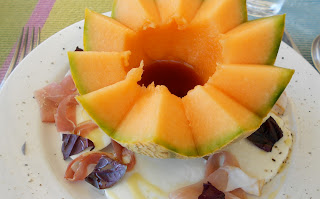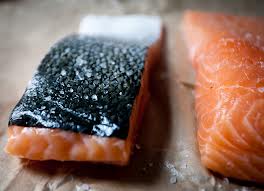In Tissonais, at Johnno's place in Brittany, the decision had been made that we'd try to cook & eat all our meals outside on the fire pit recently constructed & that all our produce had to be local. We were a little spoilt by the markets of fresh fruit & vegetables in nearby villages, also by having a country abattoir just along the road & around a corner or two. I particularly liked choosing my own cuts for mincing, which was done there & then, at the counter.
The choice of meatballs was an easy one: we all love meatballs! I mean, who doesn't?? The spice blend in this recipe can be varied to taste, as with the combination of meats; we simply chose a blend that worked for us. In this recipe, cumin/tumeric/paprika/chilli in careful amounts & for the meat a 60/40% ground beef/pork blend. It's a combination which for me is tried, tested & comes out great every time. Always delicious, this dish can be made in advance & reheated with good result. Hard to beat.
Because in Tissonais the vessel of choice was the tagine, courtesy of Nico, picked up on his wanderings around Morocco, this version was made accordingly. In fact, a good cast iron pan & a casserole dish, started on the stove & finished in the oven is what I generally do at home. Flavour is what is important. I've written before about the importance of creating a good base for flavours as you cook; taking your time & allowing that foundation to build & intensify with each layer; in the end this is what makes all the difference. Because in Tissonais we were cooking every night, we had the benefit of using the deglazed pan juices & sauce from our previous night's dinner, such as shin of beef/soy/ginger/cider dish as a base. Thick rich & saucy, it made the ideal base for our meatballs.
the ingredients: meatballs:
minced beef/lamb 60/40% ratio -1kg
garlic/onion, minced -1 onion/2 garlic cloves
salt/white pepper/cumin/tumeric/paprika/chilli powders -tspoon of each
the ingredients: the sauce:
olive oil -a good slug or so
onions/garlic/salt - 2 onions/3 garlic cloves
aubergine -1/tomato puree -1 squeeze/tomatoes -fresh 3 or 4/canned 1/silverbeet -2 leaves
the ingredients: couscous:
couscous -1 1/2 cups + boiling water 3 cups
olive oil - a good slug + a knob of butter
parsley & lemon zest
method: stage1: meatballs
*combine the beef & pork mince in a bowl & add garlic, the onions, the spices, mix well
*roll the mince into small balls & set aside (cover with a tea towel)
(tip: the onions & garlic need to be chopped as finelyfinely as you can, so they mix in well)
(tip: have a small bowl of cold water by your board & splash a little on your hands every now & then, it keeps the mince from sticking to your hands as you work)
(tip: think about size - there's no rule, but small cooks quickly & is easy business when eating)
(note: some people throw in a handful of breadcrumbs & an egg, to bind, but i prefer just meat)
method: stage2: preparation & cooking:
*wash, peel, slice & dice the remaining ingredients & have ready;
*warmed dish, olive oil, onions & garlic added, cook covered til translucent & sweet, set aside;
*add meatballs, more heat to brown lightly on each side, remove & set aside with onions;
*add the aubergine to soak up the meaty oil & cook for 5 minutes on slightly more heat til golden;
*add tomato paste & stir a little, you want it to begin to caramelise, then add tomatoes;
*when tomatoes are bubbling away, add the chiffonade of sliverbeet, folding through;
*lastly, return meatballs & onions to the dish & cover, so everything can happily simmer;
(tip: cooking the early ingredients in oil keeps the flavours intact & allows colouring; adding tomatoes at the end introduces liquid & the cookery method changes from frying to poaching/braising)
(tip: this is a dish of necessity, changing each time, so your choice of vegetables will vary according to taste/seasonal availability)
method: stage3:couscous:
*measure out the couscous, mix a little olive oil through, a knob of butter in the bowl too;
*pour over the boiling water, stir one time, cover tightly, sit for 5 minutes;
*give the container a firm tap to loosen couscous, uncover, stir thru one time to aerate;
*sprinkle over gremolata -parsley/lemon zest finely chopped
*serve either separately or combined
(tip: I find the couscous works well mixed through when the meatballs de la chateau is particularly saucy, it soaks up the juices & is easy to plate up)
Emerging over time as a clear favourite, we repeated this dish again & again as we travelled on westward & southward through France. Certain aspects would change for the purposes experimentation or when necessary, but we kept the tagine as our vessel of choice regards the cooking of our meals, just because we love it so much. What the hell, it's a matter of preference & we like it this way. The limitations of the tagine were that it was difficult to get a good heat for the sealing stage, at the start, so our meatballs came out more poached than fried, as in less browning, but the flavours were great & thats what counts. The time frame with a less intense heat is longer than normal: in Brittany we found that a few beers round the fire pit helped pass the time; in La Brugue we had to adapt to taking dips in the pool instead.

Everywhere we reproduced these meatballs, in other words, at every chateau stop along our way, the mention of this dish was always well received, from kids to grown ups, & us too. I guess it's comfort food. Certainly my mother had her own version...Now, some time later, & with my travels in France behind me, I sit typing once more with a bellyful of meatballs de la chateau, having pulled out this dish once more while I stay with my sister. I am as happy with the dish as ever.
(shared lunch including meatballs de la chateau in Brittany with Johnno & Cuz & all the clan)


















































